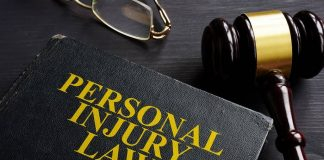Nothing can get you ready for the shock and trauma of an accident that injures you.
Whether you’ve been hurt in a car crash, a slip-and-fall, or a hit-and-run, you’ll never be ready to deal with the pain and suffering that comes from someone else’s negligence.
You may be wondering what to expect from a personal injury claim, how long to file a personal injury claim, and what steps to take if you find yourself in such a situation.
Timeline of a Personal Injury Claim

This post will outline the common steps involved in filing a claim and pursuing legal action afterincurring injuries.
The timeline for successfully filing a personal injury claim could vary. There are, however, standard procedures that are followed in most personal injury cases.
These procedures apply to instances involving construction accidents, motor vehicle accidents, medical malpractice, and other types of accidents and injuries.
#1. Medical Recovery
If you’re injured, seek medical attention immediately. Even if you’re not seriously hurt, get checked after an accident.
This includes visiting an emergency room, an urgent care center, or your regular doctor because you may be suffering from hidden or internal injuries that need medical attention.
Remember that your medical records will be the basis of any injury claim. So, make sure to keep a copy of the medical bills incurred, doctor’s prescriptions, notes, and even laboratory and x-ray results.
#2. Consult A Personal Injury Attorney
You and your personal injury attorney will talk about the accident that left you injured and the legal options available to you.
Your attorney will discuss with you the laws that are applicable to your situation and the possible courses of action you can take.
Legal fees, charges, or contingent payments will be discussed. If you engage a personal injury attorney, they’ll answer your questions and lay out the next steps you can take.
#3. Investigation
After you’ve hired a lawyer, they’ll launch their own investigation to see what happened.
In order to verify the details of your claim, it may be necessary to review your medical records, inspect the accident scene, and conduct witness interviews.
#4. Filing A Personal Injury Claim
All documentation relevant to your accident and injury insurance claims will be filed by your attorney. As soon as a claim is made, insurance companies begin looking into it.
You might hear from a claims adjuster or insurance adjuster who wants to talk about your claim.
Unless you have legal assistance, you should not give any remarks or answers. Wait for the advice of your attorney. Be cautious, since insurers will look for any reason to deny your claim.
#5. Discovery And Mediation
Once your claim has begun, the discovery process can typically take anywhere from six months to a year.
During the discovery phase, both parties will conduct an investigation into disputed facts, collect evidence, and exchange documents.
There’s a significant chance the court may require you to settle during mediation if you file a claim for personal injury.
The mediator acts as a third party who brings the parties together to work out the details of the case. The parties investigate methods of settling the dispute amicably.
Generally, if you and the other party can reach a settlement, then there is no need to proceed to trial.
#6. Early Negotiations
Your personal injury attorney will communicate with the party at fault or their insurance provider to discuss the damages caused and the extent of their liabilities.
Everything from the specifics of the accident to a detailed report on your injuries and their prognosis is included in the settlement letter. A demand for compensation detailing your losses will also be included there.
As part of the settlement process, an insurance adjuster will evaluate the documents your attorney has prepared and may have further questions. Additional discussion on the specifics of the settlement demand letters may also be needed.
If you can successfully negotiate a settlement, you will get compensation and your claim will be considered settled or closed.
#7. Going ToTrial
If reaching an agreement through the mediation process doesn’t work, or if an agreement cannot be reached with the insurance company, your case will continue to trial.
The length of a trial for personal injury could vary. It may take months or even a year. Your trial team will have you ready for everything if your case goes to court.
At trial, your attorney will submit the case’s details and evidence to the judges, including evidence of the other party’s fault and the extent of your injuries.
After hearing both sides of the case, the jury will render a verdict that must be followed by the court.
Conclusion
There is a lot to process immediately following an accident and at the outset of a personal injury case, and there are many factors to consider in relation to the circumstances.
Ultimately, hiring an attorney can guarantee that your rights are protected at every turn, that you make the most of your options, and that you are in the best possible position to win and get compensated.
























